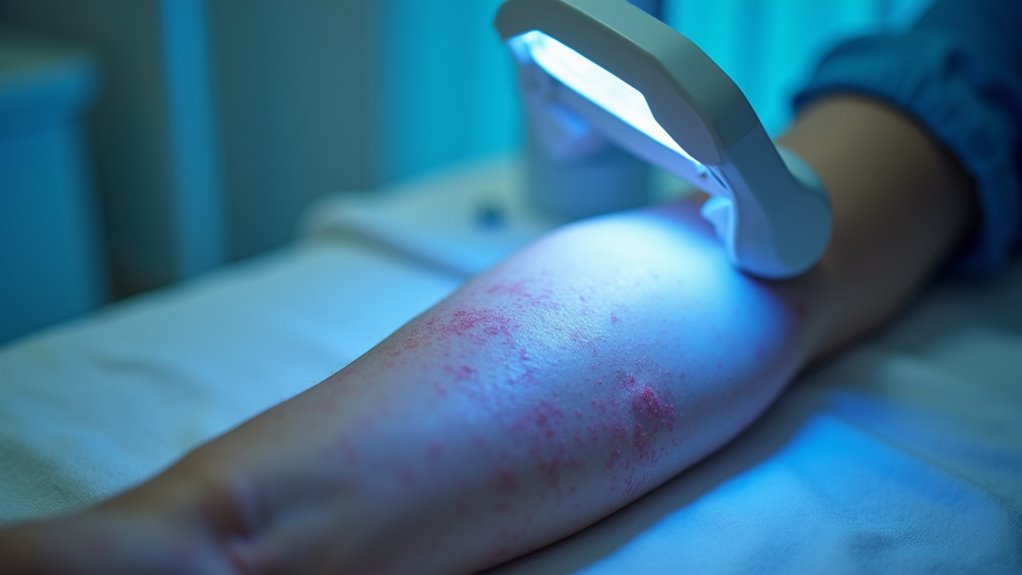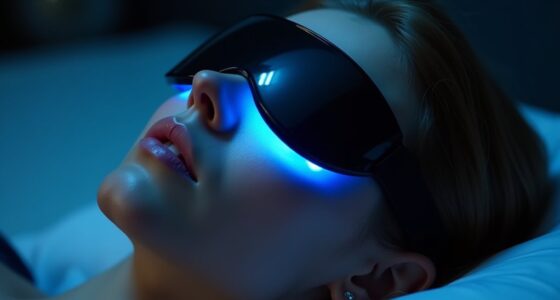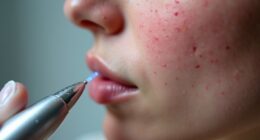LED therapy can help reduce psoriasis symptoms for some people by reducing inflammation and promoting healing through specific wavelengths of light. Studies show it may improve plaque thickness and redness, but results can vary depending on your skin type and condition severity. It’s a non-invasive option worth considering, especially when combined with other treatments. To find out if it’s suitable for you and learn more about how it works, keep exploring the details ahead.
Key Takeaways
- Multiple studies suggest LED therapy can reduce psoriasis symptoms like plaque thickness and redness.
- Effectiveness varies depending on wavelength, session duration, and individual skin response.
- LED therapy promotes healing by reducing inflammation and stimulating collagen production in skin cells.
- Side effects are generally mild, such as redness or dryness, but monitoring skin reactions is important.
- Consultation with a dermatologist is recommended to determine if LED therapy suits your specific condition.
Understanding Psoriasis and Its Traditional Treatments
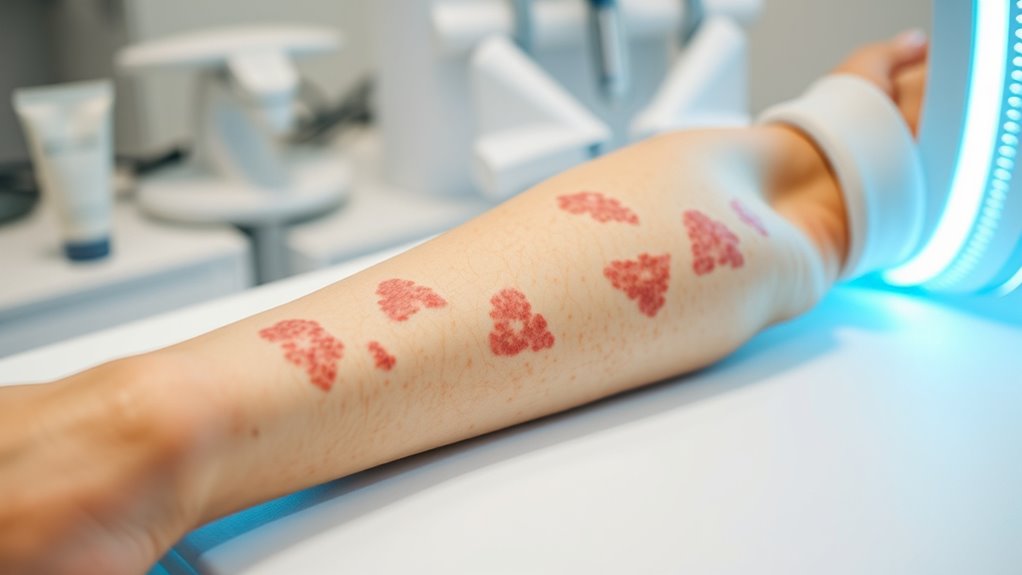
Psoriasis is a chronic autoimmune condition that causes your skin cells to multiply rapidly, leading to thick, scaly patches that can be itchy and uncomfortable. Traditional treatments mainly include topical steroids, phototherapy, and systemic medications, but many people also explore alternative therapies. These include natural remedies, herbal supplements, and dietary changes aimed at reducing inflammation. Lifestyle modifications play a vital role in managing symptoms; you might find relief by avoiding triggers like stress, smoking, and certain foods. Regular moisturizing helps keep your skin hydrated, while stress reduction techniques can lessen flare-ups. While these approaches don’t cure psoriasis, they can complement medical treatments and improve your quality of life. Incorporating natural remedies with conventional methods might enhance overall symptom control. Always consult your healthcare provider before trying new therapies or making significant lifestyle changes.
How LED Therapy Works on the Skin
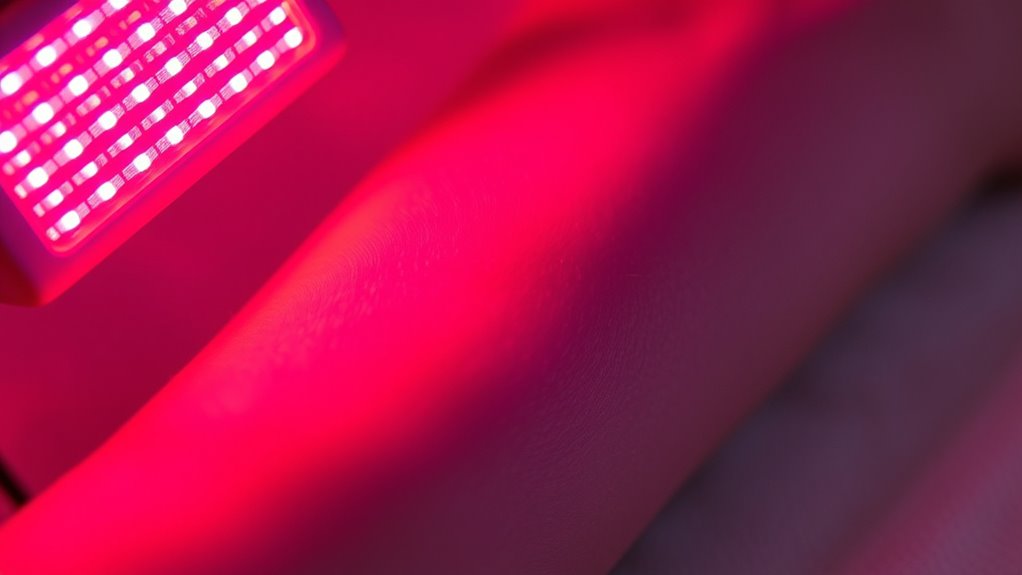
LED therapy works by using specific wavelengths of light to penetrate the skin and target underlying cellular processes. When you expose your skin to LED light, it triggers a skin response that can promote healing and reduce inflammation. Different wavelengths of LED light, such as red or blue, penetrate at varying depths and influence different cellular activities. For example, red LED light stimulates collagen production and improves blood flow, which can help soothe psoriasis-affected skin. The skin absorbs this light, activating cellular functions like increased circulation and cell regeneration. This process helps modulate the skin’s immune response and may ease symptoms. Additionally, research shows that LED therapy can influence cellular responses, promoting tissue repair and reducing inflammation. Overall, LED therapy works by harnessing specific light wavelengths to encourage your skin’s natural healing mechanisms.
Scientific Evidence Supporting LED Therapy for Psoriasis
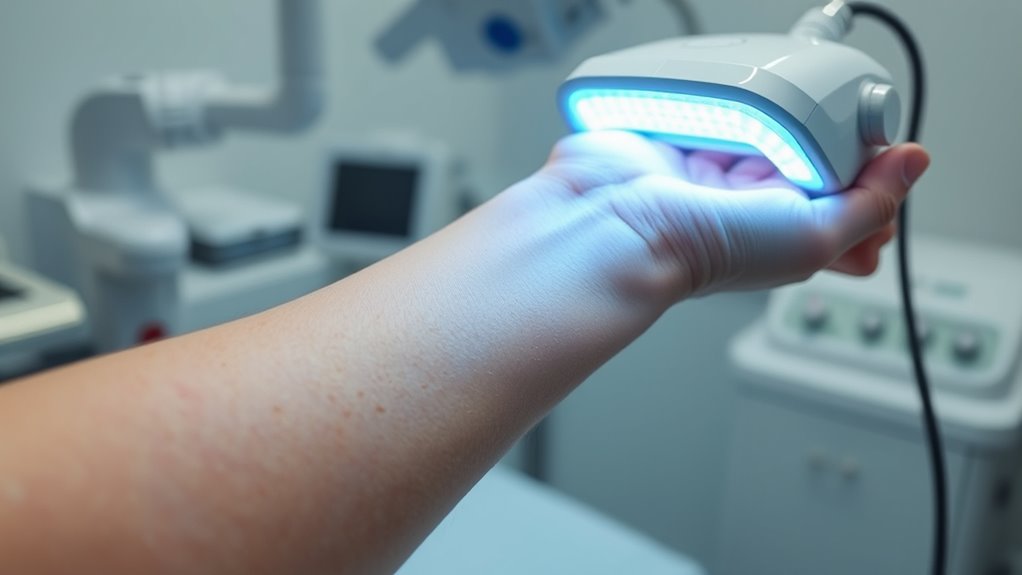
Numerous studies have investigated the effectiveness of LED therapy in managing psoriasis symptoms, providing some promising evidence. Research shows that LED efficacy depends on specific treatment protocols, including wavelength, duration, and frequency. These protocols aim to target inflammation and skin regeneration effectively. Clinical trials report improvements such as reduced plaque thickness and redness. However, results vary, and more standardized studies are needed to confirm consistent benefits. Understanding the best treatment protocols can optimize outcomes. Here’s a summary of key findings:
| Study | Findings |
|---|---|
| Smith et al. (2020) | Significant symptom reduction with red and near-infrared LEDs |
| Lee et al. (2021) | Improved skin appearance using specific treatment protocols |
| Johnson et al. (2019) | Varied results, emphasizing need for standardized protocols |
Additionally, individual responses to LED therapy can differ based on factors such as skin type and severity of psoriasis.
Practical Considerations and Potential Risks
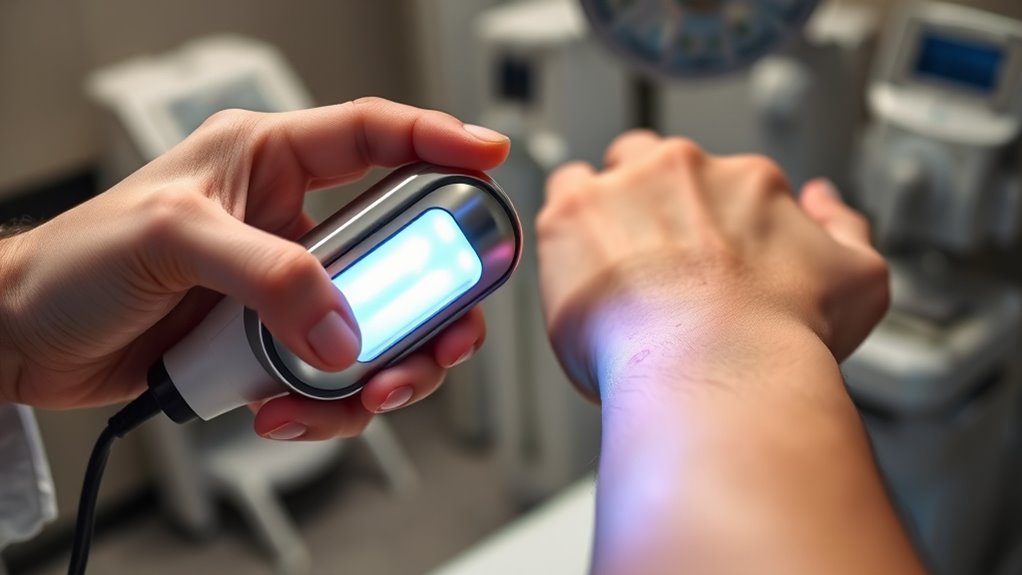
While research highlights the potential benefits of LED therapy for psoriasis, it’s important to contemplate practical aspects and possible risks before starting treatment. One concern is side effects, which are generally mild but can include redness, dryness, or temporary irritation. It’s essential to monitor how your skin reacts and consult your healthcare provider if issues persist. Additionally, treatment costs vary depending on the clinic and session frequency, so budgeting for ongoing sessions is necessary. Keep in mind that LED therapy may require multiple visits, and insurance often doesn’t cover it, making affordability a key factor. Understanding these practical considerations ensures you’re prepared for the commitment and can weigh the potential benefits against the risks and expenses involved. Proper skin care routines can also influence the overall effectiveness and safety of the therapy.
Is LED Therapy a Viable Option for You?

Deciding whether LED therapy is right for you depends on your specific skin condition, treatment goals, and lifestyle. If you’re exploring alternative therapies for psoriasis, LED therapy might be worth considering, especially if you prefer non-invasive options. It’s a low-risk treatment that can complement other approaches, like topical medications or lifestyle changes. Additionally, emerging advancements in AI in Education demonstrate how personalized treatment plans can be optimized through data-driven insights, which could someday influence dermatological therapies. However, it’s essential to consult with a dermatologist to determine if this therapy aligns with your needs. Your lifestyle, including your daily routine and ability to commit to multiple sessions, also influences its viability. LED therapy may not be suitable if you have certain medical conditions or skin sensitivities. Ultimately, weigh the benefits against your personal circumstances to decide if this treatment fits into your psoriasis management plan.
Frequently Asked Questions
How Long Does It Typically Take to See Results From LED Therapy?
You’re probably wondering how long it takes to see results from LED therapy. Typically, the treatment timeline varies, but most people notice visible improvements after about 4 to 6 weeks of consistent sessions. While some may see faster changes, patience is key. Regular treatments help enhance skin healing, so sticking with your schedule increases the chances of achieving the best possible results within this timeframe.
Are There Any Long-Term Side Effects of LED Therapy for Psoriasis?
You should be aware that long-term side effects of LED therapy for psoriasis are generally minimal, making it a safe treatment option. While side effects awareness is important, most people experience no adverse effects even after extended treatment durations. However, individual responses vary, so it’s wise to monitor your skin. If you notice persistent irritation or changes, consult your healthcare provider to adjust the treatment duration or approach.
Can LED Therapy Be Combined With Other Psoriasis Treatments?
You can definitely combine LED therapy with other psoriasis treatments to enhance your skin’s healing. The combination benefits include improved symptom relief and potentially quicker results. Treatment integration allows you to tailor your approach, using LED therapy alongside topical medications or phototherapy. Always consult your healthcare provider to guarantee safe and effective combination strategies, maximizing the benefits while minimizing risks. This personalized plan can help manage your psoriasis more effectively.
Is LED Therapy Suitable for All Types of Psoriasis?
Imagine a person with mild psoriasis finding relief through LED therapy, while someone with severe symptoms sees limited results. You should know LED therapy’s suitability depends on psoriasis severity and skin response. It’s generally effective for mild to moderate cases, but severe psoriasis might require additional treatments. Always consult a dermatologist to evaluate your specific condition, as individual responses can vary based on skin type and disease severity.
What Is the Cost Comparison Between LED Therapy and Traditional Treatments?
When comparing the cost of LED therapy to traditional treatments, you’ll find that LED therapy often has a higher initial expense but may offer better treatment affordability over time. Traditional treatments like topical creams and phototherapy can add up due to ongoing costs. Considering the cost comparison, you should weigh the long-term benefits and expenses to determine which option fits your budget and treatment needs best.
Conclusion
Just as the phoenix rises from the ashes, LED therapy offers hope for renewed skin and relief from psoriasis. While scientific evidence is promising, it’s essential to weigh the benefits against potential risks and consult your healthcare provider. Remember, no miracle cure exists, but this innovative treatment could be a step toward brighter, healthier skin—if you’re willing to explore its possibilities and set out on your own healing journey.
